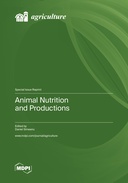Explore

Animal Nutrition and Productions
0 Ungluers have
Faved this Work
Login to Fave
The externalization of animals’ genetic potential is determined by a number of external factors, of which feeding plays a major role. Animals’ nourishment is one of the most important levers to ensure the efficiency of animal production due to both the high share of feed costs in the total cost of products and the influence this has on the growth, reproduction, and health of animals as well as the quality of products obtained from these. This field is one of the most dynamic in the field of husbandry sciences due to the takeover and permanent use of numerous results obtained from research on energy metabolism and nutrients related to the composition of feed and its influence on animal products. This is also due to the great advances in genetics, which create new types of animals with increasing productive potential, but also with different food requirements. This Special Issue collated innovative papers on animal nutrition, physiology, chemistry, biochemistry, genetics, reproduction, and breeding technologies. The articles covered a wide range of topics related to feed quality, the influence of food on the production level, the quality of production, and also on animals’ health.
This book is included in DOAB.
Why read this book? Have your say.
You must be logged in to comment.
Rights Information
Are you the author or publisher of this work? If so, you can claim it as yours by registering as an Unglue.it rights holder.Downloads
This work has been downloaded 77 times via unglue.it ebook links.
- 77 - pdf (CC BY) at Unglue.it.
Keywords
- Ajuga iva
- alternative feed
- Animal production
- antimicrobial
- AP estimation
- AP monitoring
- apparent digestibility
- biochemical analysis
- biological value
- Biology, Life Sciences
- birds’ welfare condition
- body condition score
- carcass yield
- chemical composition
- chicken
- Clostridium perfringens
- commercial cuts
- cooking loss
- corporal indice
- dairy buffaloes
- decision support
- degradability
- deletion method
- duck
- egg weight
- Escherichia coli
- European catfish
- ewes
- farming environment
- Fatty acids
- feeding trial
- female camels
- flavonoid content
- Flavonoids
- flesh yield
- flushing
- food and feed safety
- food animals
- fractional reduction
- Fractions
- FTIR
- genetic diversity
- grey cattle
- growing conditions
- hare
- Heavy metals
- Honey
- IoT
- Lactation
- lipid health indices
- livestock farming
- low cost
- Manganese
- Mathematics & science
- Meat
- meat quality
- Milk
- Minerals
- mitochondrial DNA
- mozzarella cheese
- n/a
- neutral detergent fiber
- non-fiber carbohydrate
- nutritional quality
- nutritive value
- paddlefish
- Pearson’s correlation
- phenolic
- phenolic content
- phenols
- Podolian cattle
- Pollution
- polycyclic aromatic hydrocarbons
- Production
- productive parameters
- Quality
- rabbit
- ram
- rearing system
- Reference, information & interdisciplinary subjects
- Reproduction
- reproductive and productive performances
- reproductive performance
- reproductive traits
- Research & information: general
- Saccharomyces cerevisiae
- Salmonella spp.
- secondary metabolites
- sensory properties
- shell weight
- somatometry
- sows
- sperm quality
- sustainability
- total mixed ration
- turkey
- unconventional feeds
- water-holding capacity
- Winter
- yeasts and molds
- Yucca schidigera
Links
DOI: 10.3390/books978-3-0365-8011-1Editions

